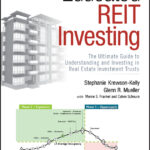The Ultimate Guide to Understanding and Investing in Real Estate Investment Trusts

“I recommend this book to anyone looking to better understand REITs
and real estate investment.”
—STEVEN A. WECHSLER , President and CEO, Nareit
A REIT, or real estate investment trust, is a company that owns, operates, or finances income-producing real estate. Pronounced REET, they differ from other real estate companies in that REITs must pay out at least 90% of their taxable income as dividends to shareholders. As a result, REITs offer attractive dividend yields and income.
Read more introductory facts about REITs in Chapter 1 of Educated REIT Investing.
Three primary reasons to include REIT shares in your investment and/or retirement portfolios are:
1) Dividend Income – REITs pay robust dividends to shareholders and, for the past decade, REIT dividend yields (defined as annualized common dividend divided by the current stock price) have exceeded the yield on the S&P 500 Index by roughly 2 percentage points.
2) Robust Total Returns – REITs historically have generated 8-12% total returns to investors over longer investment periods.
3) Portfolio Diversification – Commercial real estate is one of the four fundamental assets people can invest in and, as such, behaves differently than the other three (cash, bonds, and non-REIT stocks). As a result, adding REIT shares to a portfolio of equities and bonds generates higher returns while also reducing portfolio risk (measured as volatility, or stock price movements).
Read more about the benefits of investing in REITs in Chapter 2 of Educated REIT Investing.
Commercial real estate valuations are driven by two different cycles:
1) Physical Market Cycle, where demand for property intersects with supply of that property to determine price
2) Financial Market Cycle, which is the flow of funds through the capital markets (public and private equity and debt)
As such, it is possible to have commercial real estate valuations rise, even if supply and demand fundamentals in a market are weak.
Read more about how the physical and financial market cycles affect real estate pricing and, by extension, REIT equity values in Chapter 3 of Educated REIT Investing.
REITs payout at least 90% of their taxable income, but this does NOT mean they payout 90% of their cash. In fact, most REITs generate more cash from their properties than they payout in dividends. Provided a REIT also operates with conservative levels of debt, their dividends are safe, even during times of broader economic distress.
Read more about how to assess the safety of a REIT’s common dividends and other important dividend information in Chapter 4 of Educated REIT Investing.
Most leases provide that a landlord (the REIT) be reimbursed for a building’s operating expenses over a pre-negotiated level specified in the lease, or that the tenant pay all operating expenses directly. As a result, REIT’s operating margins tend not to be negatively affected by inflation—and REITs can often capture higher rental rates caused by an inflationary environment. Read more about the benefits and risk associated with different lease structures in Chapter 5 or Educated REIT investing.
There are two broad categories of REITs: equity REITs (that invest in income-producing properties) and mortgage REITs (that finance income-producing properties). The equity REIT market consists of approximately 180 companies with an aggregate equity market capitalization of $1.2 trillion – or 18x larger than the mortgage REIT market.
The equity REIT market consist of companies that invest in a wide array of property types, including office buildings, industrial/warehouse properties, shopping centers, self-storage, cellular towers, healthcare facilities, and data centers (to name a few). Each type of real estate generates income that is influenced by distinct demand fundamentals that, in turn, affect the way their common shares trade.
Read more about the benefits and risks associated with different property types in Chapter 6 of Educated REIT Investing.(
The mortgage REIT (or “mREIT”) market consists of approximately 40 companies with an aggregate equity market capitalization of $65 billion. Similar to very specialized banks, these companies finance commercial and residential properties by originating and/or investing in real estate loans.
Read more about mREITs in Chapter 7 of Educated REIT Investing.
Unlike other C-Corporations, REITs can issue Operating Partnership Units, or “OP Units,” as equity when acquiring commercial real estate. The OP Unit allows the seller to defer recognizing the capital gains tax due on the sale until such time as they convert their OP Units into common shares of the REIT; in the meantime, the seller collects a dividend on its OP Units. When the seller dies, his or her heirs can convert inherited OP Units into shares of the REIT at the then-current share price, thereby avoiding the capital gains tax all together.
Read more about OP Units and the other unique, more technical aspects of REITs in Chapter 8 of Educated REIT Investing.
REITs can issue debt in several forms which provides them with much greater financial flexibility than private real estate investors. REIT debt can be private, meaning they are not traded on any exchange and are owned by a lending institution, and can include mortgages, lines of credit, and bank term loans. REITs can also issue public debt securities, consisting primarily of senior notes and preferred stock.
Read more about the various forms of REIT debt and fixed income securities in Chapter 9 of Educated REIT Investing.
The short-term performance of REIT share prices is sensitive to changes in U.S. Treasury rates (or the outlook for rates). Additionally, share prices among REIT property sectors (office, hotel, etc.) perform very differently, depending on how strong the demand for a property type is and how long a REIT’s average lease length is across its portfolio.
Learn how to anticipate which REITs will outperform in different market conditions by reading Chapter 10 of Educated REIT Investing.